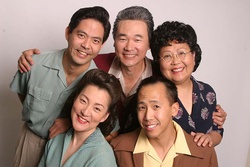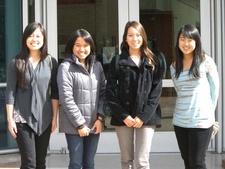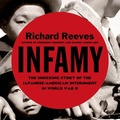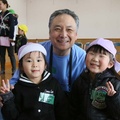I’m not an expert on Japanese culture and customs, but as I observe what’s happening in Japan after the earthquake and tsunami I am confident that the country and its people will eventually recover and rebuild their lives because of one key concept and way of life that is deeply embedded in the Japanese spirit:
“Otagaisama.” Helping each other, mutually.
More so than “gaman” (to endure), “shikata ga nai” (it can’t be helped) and phrases meant to inspire like “Gambaro Nihon” (Let’s Be Strong, Japan), Otagaisama was put to work immediately after the disaster, and is continuing on to this day. On TV we saw complete strangers reaching out and rescuing people off of roof tops. People with very little left themselves were giving up food or declining aid because “there are so many others who need it more than we do.” The idea of looting, which is in direct conflict with Otagaisama, is a completely foreign concept to the vast majority of Japanese people.
We help each other. We don’t steal their stuff.
Because of Otagaisama and their strength and spirit, the Japanese people of Northern Japan will recover, but it’s going to take time, and it’s going to take a lot of money. And they won’t be able to do it alone. That’s where we can help.
So far, I have been heartened and impressed by our community’s willingness to step up and support the Japanese people in this great time of need. Earthquake relief funds have been established, and donations from our community in the millions of dollars are reaching the Japanese people with the greatest needs.
But it’s clear that the need is not going away anytime soon, and we need to keep giving. However, there have been some in our community who have expressed a reluctance to support Japan, saying that they can’t relate, or they don’t have a close feeling or personal connections, or that Japan’s past behaviors toward the U.S. have had a negative impact on Japanese Americans. Therefore, they find it difficult to be sympathetic or supportive.
While I understand these feelings, I return to the concept of Otagaisama. If you look at our history in this country, Otagaisama was key to our survival from day one when the Issei first arrived. Living in hostile environments where they often faced extreme prejudice and hatred, the Issei quickly realized they had to help each other in large ways such as pooling their money and providing loans, and in small ways, through everyday random acts of kindness.
This spirit of mutual support, cooperation and understanding got them through their early days in this country, the Great Depression and especially during the war years in America’s concentration camps, and the extremely difficult post-war resettlement period. Just like the Japanese in Japan, Japanese in America used Otagaisama to endure, survive and eventually rebuild their lives.
In fact, after the War when Japanese Americans were forced to restart their lives with nothing but $25 and a train ticket home, Issei and Nisei, who had very little to support themselves and their own families here in the U.S. did something quite remarkable: They gathered boxes, filled them with food, clothing and other necessities and sent them to relatives in war-torn and devastated Japan.
The feeling then was simply, “We may not have much, but they need this more than we do.”
One box may not seem like much, but one box multiplied by hundreds or even thousands sent by Issei and Nisei to Japan, and it becomes an act of kindness and an offering of hope that is still remembered to this day.
I was reminded of this on a recent trip home to San Francisco for the 44th Annual Cherry Blossom Festival. Each year, during the annual Queen coronation, the story of the Fujiyasu Furisode Kimono is told. Since 1973, this kimono company, based in Tokyo, has donated a precious furisode kimono for the festival’s new queen.
The reason for this generous donation goes back to after the War. When the situation in Japan was turning from desperate to hopeless, these boxes from America all of a sudden began arriving. The president of the Fujiyasu Kimono Company, Mr. Seishichi Ato and his family were among those fortunate to receive these precious gifts so many years ago, and with it was a chance to rebuild their lives and country.
Seishichi Ato never forgot this, and the annual kimono donation has been his way of repaying a kindness to the Japanese American community.
In my own family, my mother’s cousins from Hiroshima told us a couple years ago they still remember the boxes of coffee, chocolates and pencils that my grandparents sent there after the atomic bomb destroyed their entire city. My father’s cousins in Wakayama told my father they were the envy of their school because of the clothing my grandmother had sent to them. These simple acts of kindness had never been forgotten.
Otagaisama. We help each other.
And now, after Japanese Prime Minister Naoto Kan stated that Japan is facing its worst disaster since World War II, it’s time for us to give again.
Otagaisama is part of our history and tradition. I’m proud to say that this is so, and happy to be carrying on in the tradition of our Issei and Nisei elders. It is part of who we are as Japanese Americans, and as human beings.
* * * * *
In this spirit, our theater group, the Grateful Crane Ensemble, will be performing a benefit show for Japan disaster relief on Saturday, May 14, 2011, at 4 p.m. at the Orange County Buddhist Church in Anaheim.

Grateful Crane's "Moonlight Serenaders" will perform camp songs in the "Best of Grateful Crane" show.
“The Best of Grateful Crane” show will feature the best songs and numbers we have performed over the past ten years of our existence. Japanese favorites such as “Koko ni Sachi Ari,” “Yawara,” and “Kawa no nagare no youni” as well as American classics such as “Moonlight Serenade,” “At Last” and “I’ll Be Seeing You” will be featured.
I hope you can come out, and show your support for Japan.
100% of ticket proceeds will be donated to the Northern Japan Earthquake Relief Fund, which has already raised nearly $1.6 million in direct relief funds for Japanese people in the most affected areas. The fund, established by the Japanese Cultural and Community Center of Northern California (JCCCNC) in San Francisco, was selected because 100% of donated funds are going for direct relief (with no administration fees taken out), and the fact that the JCCCNC has contacts in place and a track record of providing earthquake relief for Japan when it raised $600,000 during Kobe quake in 1995.
Benefit show sponsors include the Grateful Crane Ensemble, actor Rodney Kageyama, Hiroshi and Sadako Kashiwagi, Tak & Terry Kosakura, Tomiye Sumner, FIA Insurance Services, Fukui Mortuary, Soji & Keiko Kashiwagi, Masayo Nishikawa and the Orange County Buddhist Church.
“The Best of Grateful Crane” show will feature the singing of Jason Fong, Haruye Ioka, Keiko Kawashima, Darrell Kunitomi, Kurt Kuniyoshi, Aimee Machida, Merv Maruyama, Mary Kageyama Nomura, Helen H. Ota and Fusako Shiotani. The newly formed Grateful Crane Youth Singers will also perform. The group includes Aimee Machida, Alyssa Nakamoto, Erika Mariko Olsen and Miko Shudo.
The “Best of Grateful Crane” band includes Scott Nagatani, Danny Yamamoto, Lisa Joe and Gordon Bash.
A donation of $50.00 per person is requested for this special benefit show. The Orange County Buddhist Church is located at 909 S. Dale Avenue in Anaheim. Free parking is available. For tickets and information, call the Grateful Crane ticket line at 310/995-5841.
© 2011 Soji Kashiwagi







